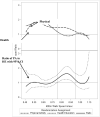Hospitalizations During a Physical Activity Intervention in Older Adults at Risk of Mobility Disability: Analyses from the Lifestyle Interventions and Independence for Elders Randomized Clinical Trial
- PMID: 27225353
- PMCID: PMC4887151
- DOI: 10.1111/jgs.14114
Hospitalizations During a Physical Activity Intervention in Older Adults at Risk of Mobility Disability: Analyses from the Lifestyle Interventions and Independence for Elders Randomized Clinical Trial
Abstract
Objectives: To determine whether moderate-intensity physical activity (PA) and health education (HE) are differentially associated with categories of hospitalizations or subgroups of participants.
Design: Multicenter randomized controlled trial in which participants were randomized to a PA or HE program for an average of 2.6 years.
Setting: Eight field centers.
Participants: Sedentary men and women aged 70-89 with lower extremity physical limitations but able to walk 400-m in 15 minutes or less (N = 1,635).
Interventions: Structured, moderate-intensity PA (n = 818) at a center (2×/wk) and at home (3-4×/wk) that included aerobic, strength, balance, and flexibility training or HE (n = 817) of educational workshops and upper extremity stretching exercises.
Measurements: All-cause inpatient hospitalizations ascertained at 6-month intervals.
Results: There were 1,458 hospitalizations (49.1% of PA, 44.4% of HE; risk difference = 4.68%, 95% confidence interval (CI) = -0.18-9.54; hazard ratio (HR) = 1.16, 95% CI = 1.00-1.34). The intervention effect on incident hospitalization did not differ according to race, sex, Short Physical Performance Battery score, age, or history of cardiovascular disease or diabetes mellitus. PA was associated with higher rates of hospitalization in the middle baseline gait speed category, than HE (<0.8 m/s: HR = 0.93, 95% CI = 0.76-1.14; 0.8-1.0 m/s: HR = 1.54, 95% CI = 1.23-1.94; >1.0 m/s: HR = 1.05, 95% CI = 0.67-1.65; interaction P = .005).
Conclusion: A PA program in older adults at risk for mobility disability did not lead to a different risk of specific types of hospitalizations than a HE program overall. Baseline gait speed may be a marker for risk of hospitalization during a PA intervention, because individuals with moderate baseline gait speed in the PA group had slightly higher rates of hospitalization than those in the HE group.
Trial registration: ClinicalTrials.gov identifier: NCT01072500.
Keywords: hospitalizations; mobility disability; older adults; physical activity; safety.
© 2016, Copyright the Authors Journal compilation © 2016, The American Geriatrics Society.
Figures




References
-
- Li CL, Sheu JT, Wang TA, et al. The relationship between healthy lifestyle and hospital utilization among adults with diabetes: Results from a national cohort in Taiwan. Asia Pac J Public Health. 2015;27:303–313. - PubMed
-
- Perkins AJ, Clark DO. Assessing the association of walking with health services use and costs among socioeconomically disadvantaged older adults. Prev Med. 2001;32:492–501. - PubMed
-
- Martin MY, Powell MP, Peel C, et al. Leisure-time physical activity and health-care utilization in older adults. J Aging Phys Act. 2006;14:392–410. - PubMed
-
- LaCroix AZ, Leveille SG, Hecht JA, et al. Does walking decrease the risk of cardiovascular disease hospitalizations and death in older adults? J Am Geriatr Soc. 1996;44:113–120. - PubMed
Publication types
MeSH terms
Associated data
Grants and funding
LinkOut - more resources
Full Text Sources
Other Literature Sources
Medical

